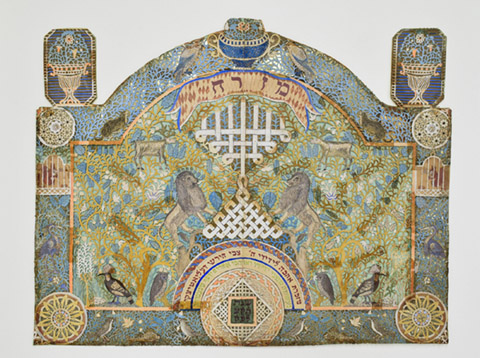Mizrah
Russia, 1810
Ink and gouache on cut paper, h 11 ¾ x w. 15 ¾ in.
B’nai B’rith Klutznick Collection of the Skirball Museum; gift of Joseph B. and Olyn Horwitz, TAP 0574
Mizrah is the Hebrew word for “east” and the direction that Jews in the Diaspora west of Israel face during prayer. Practically speaking Jews face the city of Jerusalem when praying, and those people north, east, or south of Jerusalem face south, west, and north respectively. In European and Mediterranean communities west of Israel, the word mizrach also refers to the wall of the synagogue that faces east, where seats are reserved for the rabbi and other dignitaries. In addition, mizrah or mizrach refers to an ornamental wall plaque used to indicate the direction of prayer in a Jewish home.
The symmetrical papercut for the eastern wall shown here is an example of folk art popular in the 19th century. Its arched silhouette is filled with delicate floral motifs and geometric forms—circles, arches, squares, and rhombuses—all cut with great precision. Other motifs include various species of water fowl, caged squirrels, fish, and a pair of lions.
The papercut is inscribed with the word “Mizrah” at the top, and the following words at the bottom: “This papercut was prepared as a gift to a friend by Ephraim Joseph Ginsburg.”
This mizrah recently appeared at Miami University’s Richard and Carole Cocks Art Museum as part of the exhibition Experiencing the Divine: Devotional Practices of Islam, Judaism & Christianity. It will go on view for the first time at the Skirball Museum in the second-floor auditorium gallery of Mayerson Hall later this summer.
Exhibitions: Experiencing the Divine: Devotional Practices of Islam, Judaism & Christianity,
Richard and Carole Cocks Art Museum, Miami University, Oxford, OH, January 24—June 10 2023.
Publications: In the Spirit of Tradition: The B’nai B’rith Klutznick Museum, ed. Linda Altshuler, 1988, p. 67, no. 1, ill. frontispiece.

